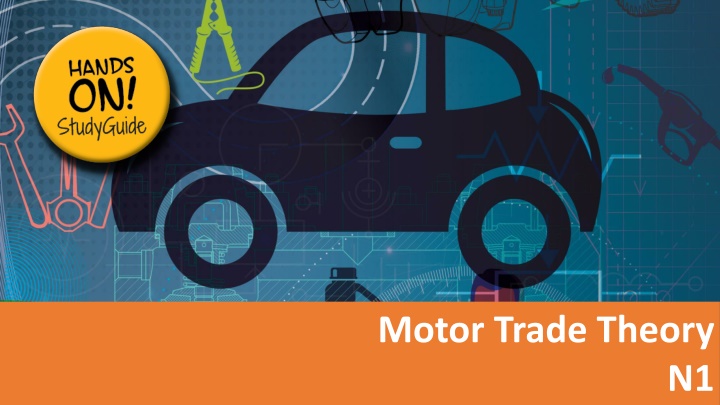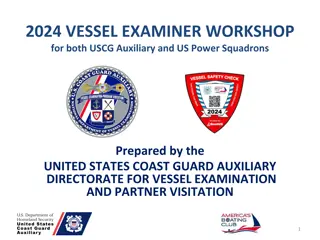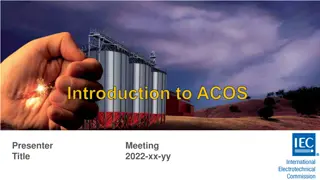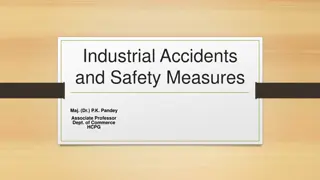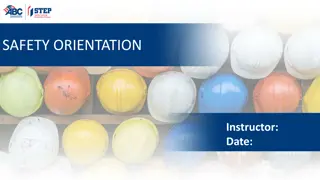Importance of Safety Measures in the Workshop for Efficiency and Lives
Safety measures play a crucial role in the workshop environment by saving time, energy, and even lives. Good housekeeping practices are essential for maintaining a safe and productive workspace. Prioritizing safety leads to increased efficiency and minimizes the risk of accidents or injuries, ultimately benefiting both the workers and the overall operations of the workshop. Emphasizing safety protocols ensures a smooth workflow and a healthy environment for all individuals involved in motor trade activities.
Download Presentation

Please find below an Image/Link to download the presentation.
The content on the website is provided AS IS for your information and personal use only. It may not be sold, licensed, or shared on other websites without obtaining consent from the author.If you encounter any issues during the download, it is possible that the publisher has removed the file from their server.
You are allowed to download the files provided on this website for personal or commercial use, subject to the condition that they are used lawfully. All files are the property of their respective owners.
The content on the website is provided AS IS for your information and personal use only. It may not be sold, licensed, or shared on other websites without obtaining consent from the author.
E N D
Presentation Transcript
Module 1: Safety and health in the workshop TEACHING SAFETY MEASURES Safety is important in the workshop in order to save time, energy and even lives. www.futuremanagers.com
Module 1: Safety and health in the workshop (continued) GOOD HOUSEKEEPING Good housekeeping means there is a place for everything, and that everything is in its place. Good housekeeping is the basis for safe working conditions. www.futuremanagers.com
Module 1: Safety and health in the workshop (continued) ACCIDENTS An accident can be defined as an unforeseen and uncontrolled event caused by dangerous actions and dangerous conditions. www.futuremanagers.com
Module 1: Safety and health in the workshop (continued) HYGIENE AND SAFETY IN THE WORKSHOP It is important to ensure that workers work under healthy conditions and the responsibility for a hygienic workplace lies with employers and employees alike. www.futuremanagers.com
Module 1: Safety and health in the workshop (continued) SAFE HANDLING OF COMPRESSORS The compressor is driven by an electric motor, therefore all precautions related to electricity must be taken at all times. The compressor and the compressed air cylinder form a unit and should be housed in a separate room. www.futuremanagers.com
Module 1: Safety and health in the workshop (continued) SAFE HANDLING OF HYDRAULIC PRESSES AND APPARATUS The platform on which the workpiece is resting must be rigid, level and at right angles to the cylinder of the press. To prevent damage to soft material, the prescribed equipment and supports must be applied. www.futuremanagers.com
Module 1: Safety and health in the workshop (continued) HOISTS, JACKS AND TRESTLES A hoist designed to support the motor vehicle under an axle or other parts of the chassis should be placed so that the vehicle is raised evenly. Supports of different lengths are available for this purpose. Before the hoist is operated, care should be taken to support the mass of the motor vehicle evenly over the hoist. www.futuremanagers.com
Module 1: Safety and health in the workshop (continued) CARE, STORAGE AND SAFE HANDLING OF CUSTOMERS VEHICLES Make sure you return every vehicle you have worked on in a better mechanical condition and cleaner than when it came into the shop. When you repair a vehicle, always do the best job you can a satisfied customer will bring his or her vehicle to you again. www.futuremanagers.com
Module 1: Safety and health in the workshop (continued) TOWING A VEHICLE It is often necessary for you to collect a stationary or damaged vehicle to bring it to your workshop. All equipment required for towing must be in good working condition equipment showing any faults or deficiencies must not be used. www.futuremanagers.com
Module 2: Workshop measuring tools TOOLS IN THE MODERN WORKSHOP Modern workshops increasingly need electronic measuring and diagnostic equipment to deal with vehicles with many electronic and computerised systems. www.futuremanagers.com
Module 2: Workshop measuring tools (continued) BASIC HAND TOOLS The most common tools are: Spanners; Hacksaws; Pliers; Files; Screwdrivers; Chisels; and Hammers; Centre and prick punches. www.futuremanagers.com
Module 2: Workshop measuring tools (continued) SPECIAL WORKSHOP TOOLS AND EQUIPMENT Apart from the large variety of general hand tools, the competent motor mechanic also requires various special tools, instruments and equipment for dealing with particular tasks related to motor vehicles. This includes the torque wrench, brake spring pliers, battery pliers, piston ring compressor, piston ring spreader, valve spring lifter, vale grinder, and screw cutters. www.futuremanagers.com
Module 2: Workshop measuring tools (continued) GENERAL TOOLS USED IN A WORKSHOP This includes but is not limited to: Trestles; Hydraulic jack; Battery charger; Manual and electrical hydraulic presses; Motor car creeper and tool stand; and Ball joint puller. www.futuremanagers.com
Module 2: Workshop measuring tools (continued) MEASURING AND MARKING INSTRUMENTS The modern motor car is a precision-made mechanism with extremely fine tolerances. Even simple measuring tasks and settings such as valve clearances and backlash must be done with a great deal of precision. www.futuremanagers.com
Module 3: Engine components THE CYLINDER BLOCK The cylinder block is the main engine assembly that houses the crankshaft, the pistons and their connecting rods and is made to accommodate the forces generated by combustion. www.futuremanagers.com
Module 3: Engine components (continued) WATER JACKET These cylinder blocks are cast with intricate passages, called water jackets, through which the coolant is circulated by a pump. www.futuremanagers.com
Module 3: Engine components (continued) THE CYCLINDER HEAD The cylinder head serves as a lid for the cylinders. When the air-petrol mixture is compressed in the cylinders and ignited, the resulting pressure is contained by the cylinder head to force down the pistons. www.futuremanagers.com
Module 3: Engine components (continued) THE CRANKSHAFT The crankshaft is the main moving part of the engine. It is fitted into the cylinder block (or crankcase) and supported by a range of bearings. www.futuremanagers.com
Module 3: Engine components (continued) THE PISTON The piston and its valves form an air pump that creates a partial vacuum in the cylinder during the intake (down) stroke. The piston is a hollow cylinder, open at the bottom. The closed is called the piston crown and forms part of the combustion chamber. www.futuremanagers.com
Module 3: Engine components (continued) PISTON RINGS There are two types of piston rings: compression and oil control rings. Their number and arrangement vary from engine to engine, but generally all compression rings are fitted above the gudgeon pin while oil control rings are fitted below it. www.futuremanagers.com
Module 3: Engine components (continued) THE CAMSHAFT The main function of the camshaft is to convert the rotary movement of the crankshaft into the reciprocating movement of the valves and to open the valves at their pre-determined intervals. www.futuremanagers.com
Module 3: Engine components (continued) TIMING (CAMSHAFT) GEARS, CHAINS AND BELTS Camshafts are commonly driven by one of three arrangements from the front of the crankshaft a gear train, chain or a toothed rubber belt. Camshafts run at half engine speed so the drive has to be stepped down from the crankshaft by having twice the number of teeth on the crankshaft gear, pulley or sprocket than on the camshaft. www.futuremanagers.com
Module 3: Engine components (continued) VALVE LIFTERS Valve lifters are used in pushrod (overhead-valve) engines and are designed to follow the shape of the pear-shaped cam on the camshaft and use this lift to push down and open a valve. www.futuremanagers.com
Module 3: Engine components (continued) PUSHRODS The pushrod has the simple function of transmitting the reciprocating movement of the valve lifter to the rocker that opens a valve. www.futuremanagers.com
Module 3: Engine components (continued) ROCKERS The rocker transmits the reciprocating movement of the pushrod to the valve stem. www.futuremanagers.com
Module 3: Engine components (continued) VALVES AND SPRINGS Four-stroke engines use valve springs to close their valves and to keep them closed for better sealing to prevent loss of pressure. The valve spring is kept onto the valve by means of a valve spring retainer and two halfmoon cotters. www.futuremanagers.com
Module 3: Engine components (continued) EXHAUST AND INLET MANIFOLDS The intake manifolds convey the fuel-air mixture from the carburettor or fuel injection system to the cylinders and help to promote vaporisation of the air- petrol mixture before admitting it to the cylinders. www.futuremanagers.com
Module 3: Engine components (continued) GASKETS AND SEALS Gaskets are used in assemblies such as gearboxes that are bolted together. A gasket or seal for an assembly that is not subject to heat can be a simple thick paper or cork pattern. www.futuremanagers.com
Module 3: Engine components (continued) CYLINDER HEAD Revolving shafts on the inside of an engine that end outside, such as the crankshaft or wheel bearings, must be sealed against oil loss and dust, and have seals made of a metal cover with a spring-loaded neoprene rubber ring that fits tightly around the shaft. www.futuremanagers.com
Module 3: Engine components (continued) CARBURETTOR Carburettors supply the internal combustion engine with an air-fuel mixture that varies in ratio to suit a range of conditions. www.futuremanagers.com
Module 3: Engine components (continued) IGNITION COIL The ignition coil transforms the 12 volt DC current from the battery to the high voltage (between 16 000 volts and 22 000 volts) required to create a timed spark across the spark plug gap that ignites the fuel-air mixture in the cylinder. www.futuremanagers.com
Module 3: Engine components (continued) SPARK PLUGS Spark plugs are screwed into the combustion chambers of petrol engines and provide the spark that ignites the mixture towards the end of the compression stroke. www.futuremanagers.com
Module 3: Engine components (continued) DISTRIBUTOR The distributor collects the high voltage sparks from the coil and conveys it to the different spark plugs in the correct order and at the right instant during the ignition cycle. www.futuremanagers.com
Module 3: Engine components (continued) STARTER MOTOR The starter is an electric motor that engages temporarily with the ring gear around the clutch plate to make the crankshaft rotate fast enough to start the engine www.futuremanagers.com
Module 3: Engine components (continued) ALTERNATOR Modern cars use AC alternators instead of the older DC generators to provide electrical power for charging the car battery. www.futuremanagers.com
Module 3: Engine components (continued) BEARINGS AND BUSHES A modern internal combustion engine uses a variety of plain and ball or roller bearings as well as bushes to support all the moving parts and reduce play and friction. www.futuremanagers.com
Module 3: Engine components (continued) PISTON RINGS Bushes are plain one-piece bearings that tend to be longer than plain bearings. They are made from brass or phosphor bronze, which is porous and can be impregnated with oil to reduce friction, and are used around gudgeon pins, for valve guides and in gearboxes. www.futuremanagers.com
Module 3: Engine components (continued) FLYWHEEL Because the internal combustion engine delivers its power in spurts once every two or four revolutions, it needs a flywheel that can store some of the energy generated during a power stroke to keep the engine moving during the other stroke or strokes. www.futuremanagers.com
Module 3: Engine components (continued) FUEL PUMPS The fuel pump is used to supply fuel from the petrol tank to the carburettor or fuel injector at a pre-set pressure at all engine speeds. www.futuremanagers.com
Module 3: Engine components (continued) WATER PUMP The water pump is mounted at the front of the engine between the engine block and the radiator, and keeps the coolant circulating from the engine block and cylinder head and back. www.futuremanagers.com
Module 3: Engine components (continued) MATERIALS USED IN MOTOR VEHICLES The modern motor vehicle uses a wide variety of materials, some known for thousands of years like iron and copper, some dating from the space age like plastics and titanium. Iron and steel make up the bulk of the materials used in motor vehicles because the base metal iron is cheap, tough, easy to process and turn into a variety of alloys or heat treat for special applications. www.futuremanagers.com
Module 3: Engine components (continued) PROPERTIES OF MATERIALS Tenacity; Elasticity; Malleability; Ductility; Plasticity; Toughness; and Hardness. www.futuremanagers.com
Module 4: Drive trains THE SINGLE PLATE CLUTCH Because internal combustion engines deliver most of their torque at higher revolutions, they need clutches that can be made to slip until the vehicle can move off. In manual transmissions the clutch must be let out smoothly and gradually feed in torque until the vehicle is moving fast enough to let the clutch out completely. www.futuremanagers.com
Module 4: Drive trains (continued) THE CLUTCH ASSEMBLY The clutch assembly consists of a series of flat, smooth surfaces that can be locked together by friction when the clutch pedal is let out. These friction surfaces are the outside face of the flywheel, the double-sided pressure plate and finally the clutch plate that is operated by a foot pedal. www.futuremanagers.com
Module 4: Drive trains (continued) PRESSURE PLATES There are two types of friction clutches in use: the helical spring-type pressure plate and the diaphragm spring type. www.futuremanagers.com
Module 4: Drive trains (continued) THE CLUTCH PLATE The ideal clutch plate must perform the following functions: It must create a firm link between the engine and the gearbox without slipping; Be able to be completely released quickly and easily take up the drive smoothly without sticking or jerking; and Be able to dissipate all the heat created by friction without damage, even under heavy loads. www.futuremanagers.com
Module 4: Drive trains (continued) CLUTCH RELEASE MECHANISMS The linkages between the clutch pedal and the clutch assembly may be mechanical or hydraulic and some bigger models may have power assistance. Mechanical linkages must include some form of adjustment to compensate for wear and maintain the correct free play between the release bearing and the pressure plate fingers. www.futuremanagers.com
Module 4: Drive trains (continued) THE CLUTCH RELEASE BEARING Two types of bearings are used to apply pressure to the pressure plate fingers and disengage the clutch: the graphite (or carbon) ring and the ball- bearing types. www.futuremanagers.com
Module 4: Drive trains (continued) CLUTCH PEDAL FREE PLAY Clutch free play should be set according to the manufacturer s instructions normally 20 mm movement at the clutch pedal before resistance is felt will be sufficient. www.futuremanagers.com
